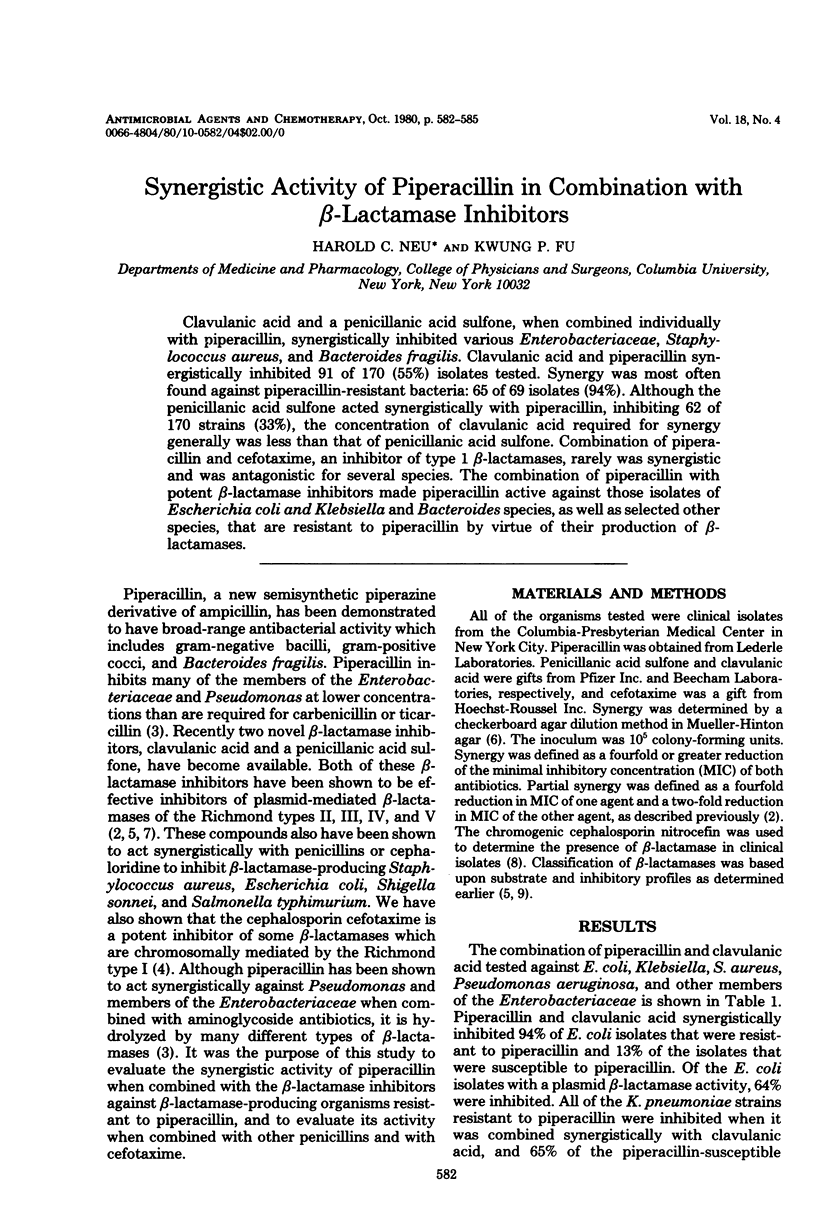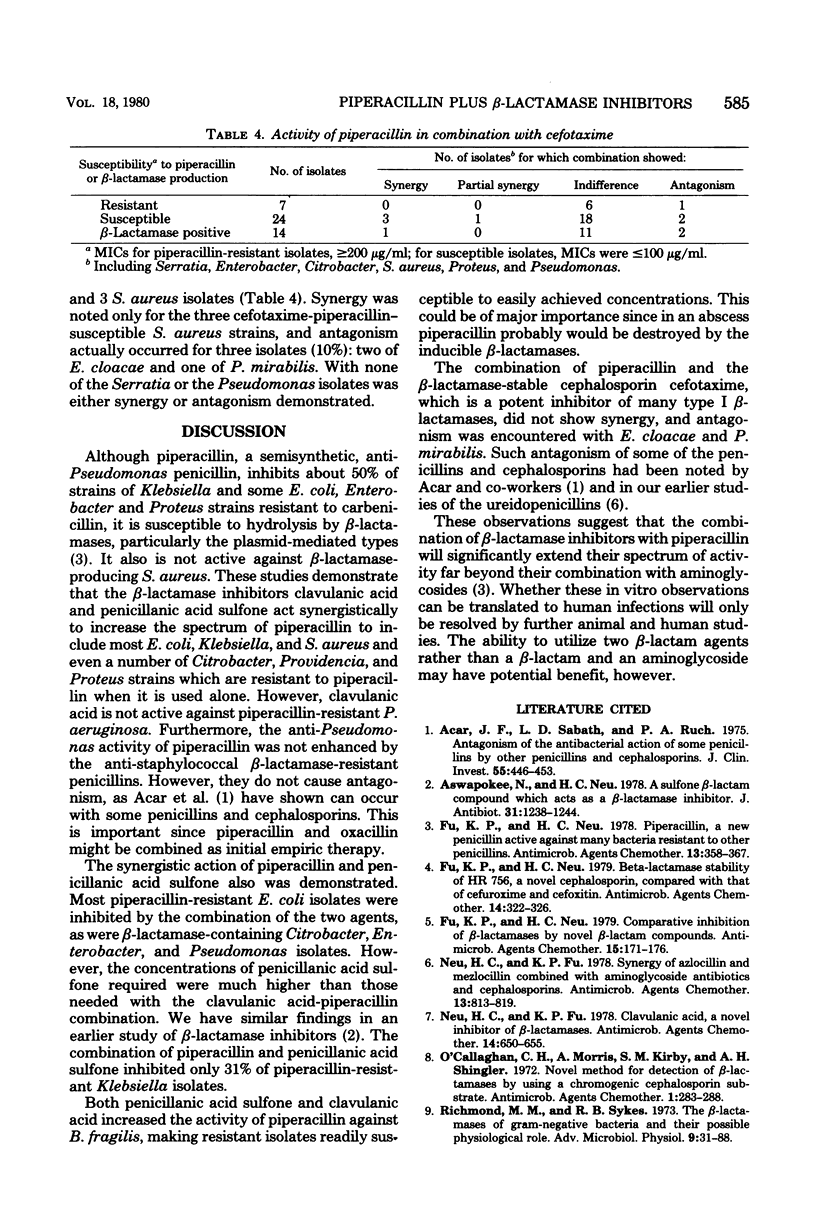Abstract
Clavulanic acid and a penicillanic acid sulfone, when combined individually with piperacillin, synergistically inhibited various Enterobacteriaceae, Staphylococcus aureus, and Bacteroides fragilis. Clavulanic acid and piperacillin synergistically inhibited 91 of 170 (55%) isolates tested. Synergy was most often found against piperacillin-resistant bacteria: 65 of 69 isolates (94%). Although the penicillanic acid sulfone acted synergistically with piperacillin, inhibiting 62 of 170 strains (33%), the concentration of clavulanic acid required for synergy generally was less than that of penicillanic acid sulfone. Combination of piperacillin and cefotaxime, an inhibitor of type 1 beta-lactamases, rarely was synergistic and was antagonistic for several species. The combination of piperacillin with potent beta-lactamase inhibitors made piperacillin active against those isolates of Escherichia coli and Klebsiella and Bacteroides species, as well as selected other species, that are resistant to piperacillin by virtue of their production of beta-lactamases.
Full text
PDF



Selected References
These references are in PubMed. This may not be the complete list of references from this article.
- Acar J. F., Sabath L. D., Ruch P. A. Antagonism of the antibacterial action of some penicillins by other penicillins and cephalosporins. J Clin Invest. 1975 Mar;55(3):446–453. doi: 10.1172/JCI107950. [DOI] [PMC free article] [PubMed] [Google Scholar]
- Aswapokee N., Neu H. C. A sulfone beta-lactam compound which acts as a beta-lactamase inhibitor. J Antibiot (Tokyo) 1978 Dec;31(12):1238–1244. doi: 10.7164/antibiotics.31.1238. [DOI] [PubMed] [Google Scholar]
- Fu K. P., Neu H. C. Comparative inhibition beta-lactamases by novel beta-lactam compounds. Antimicrob Agents Chemother. 1979 Feb;15(2):171–176. doi: 10.1128/aac.15.2.171. [DOI] [PMC free article] [PubMed] [Google Scholar]
- Fu K. P., Neu H. C. Piperacillin, a new penicillin active against many bacteria resistant to other penicillins. Antimicrob Agents Chemother. 1978 Mar;13(3):358–367. doi: 10.1128/aac.13.3.358. [DOI] [PMC free article] [PubMed] [Google Scholar]
- Fu K. P., Neu H. C. beta-lactamase stability of HR 756, a novel cephalosporin, compared to that of cefuroxime and cefoxitin. Antimicrob Agents Chemother. 1978 Sep;14(3):322–326. doi: 10.1128/aac.14.3.322. [DOI] [PMC free article] [PubMed] [Google Scholar]
- Neu H. C., Fu K. P. Clavulanic acid, a novel inhibitor of beta-lactamases. Antimicrob Agents Chemother. 1978 Nov;14(5):650–655. doi: 10.1128/aac.14.5.650. [DOI] [PMC free article] [PubMed] [Google Scholar]
- Neu H. C., Fu K. P. Synergy of azlocillin and mezlocillin combined with aminoglycoside antibiotics and cephalosporins. Antimicrob Agents Chemother. 1978 May;13(5):813–819. doi: 10.1128/aac.13.5.813. [DOI] [PMC free article] [PubMed] [Google Scholar]
- O'Callaghan C. H., Morris A., Kirby S. M., Shingler A. H. Novel method for detection of beta-lactamases by using a chromogenic cephalosporin substrate. Antimicrob Agents Chemother. 1972 Apr;1(4):283–288. doi: 10.1128/aac.1.4.283. [DOI] [PMC free article] [PubMed] [Google Scholar]
- Richmond M. H., Sykes R. B. The beta-lactamases of gram-negative bacteria and their possible physiological role. Adv Microb Physiol. 1973;9:31–88. doi: 10.1016/s0065-2911(08)60376-8. [DOI] [PubMed] [Google Scholar]


